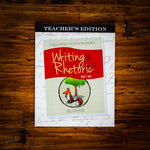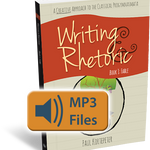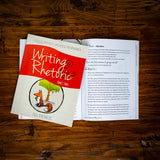- Description
- Includes
- Support
- Testimonials
-
A one-semester course for grades 3 or 4 and up
A Creative Approach to the Classical Progymnasmata—Think of the progymnasmata as a step-by-step apprenticeship in the art of writing and rhetoric. What is an apprentice? It is a young person who is learning a skill from a master teacher. Our students will serve as apprentices to the great writers and great stories of history.
Students are often expected to write with no clear model before them. Modern composition scolds traditional writing instruction as rote and unimaginative. It takes imitation to task for a lack of freedom and personal expression. And yet, effective communication from writer to reader always requires some sort of form and structure. Many of history’s greatest writers learned by imitation. In other words, writing takes the same kind of determined study as ballet or diving. Creativity uses conventional form as a stage or a springboard from which to launch grand jetés and somersaults. Too often students are expected to tackle complex writing assignments without learning the necessary intermediate steps. The assumption is that because most everyone can speak English well enough to be understood, and form letters with a pencil, that everyone should be able to write well. Yet how many of us would expect a child to sit at a piano, without piano lessons, and play a concerto? Writing is never automatic.
The Writing & Rhetoric series method employs fluent reading, careful listening, models for imitation, and progressive steps. It assumes that students learn best by reading excellent, whole-story examples of literature and by growing their skills through imitation. Each exercise is intended to impart a skill (or tool) that can be employed in all kinds of writing and speaking. The exercises are arranged from simple to more complex. What’s more, the exercises are cumulative, meaning that later exercises incorporate the skills acquired in preceding exercises. This series is a step-by-step apprenticeship in the art of writing and rhetoric. Fable is the first in a series of 12 books that will train students over 6 years, starting in grades 3 or 4 and up.
Full program includes:
-
Writing & Rhetoric Book 1: Fable (consumable student edition) This book teaches students the practice of close reading and comprehension, summarizing a story aloud and in writing, and amplification of a story through description and dialogue. Students learn how to identify different kinds of stories; determine the beginning, middle, and end of stories; recognize point of view; and see analogous situations, among other essential tools. Lessons include:
- Narration/telling it back (creating a natural sense of outline/sequence)
- Analogy—learning how this story is like/different from other stories
- Comprehension
- Sentence play/word play
- Rewriting (gaining a sense of internal structure of a piece of writing)
- Summary
- Amplification
- Rewriting given stories
- Speak It—experiencing the story from your own mouth (orally) with an audience for a different point of contact, often with some sort of change than the first time you heard it.
- Writing & Rhetoric Book 1: Fable Teacher’s Edition This teacher’s edition includes the complete student text, as well as answer keys, teacher's notes, and explanations. For every writing assignment, this edition also supplies descriptions and examples of what excellent student writing should look like, providing the teacher with meaningful and concrete guidance.
- Writing & Rhetoric Book 1: Fable Audio Files These audio files allow students to engage their sense of hearing and their listening intelligence as Dr. Christopher Perrin, along with the Writing and Rhetoric series editor, Christine Perrin, deliver the fables aloud in a thoughtful manner.
See the Support tab above for suggested schedule and rubrics.



-
Writing & Rhetoric Book 1: Fable (consumable student edition) This book teaches students the practice of close reading and comprehension, summarizing a story aloud and in writing, and amplification of a story through description and dialogue. Students learn how to identify different kinds of stories; determine the beginning, middle, and end of stories; recognize point of view; and see analogous situations, among other essential tools. Lessons include:
-
The following items are included in this bundle:

Writing & Rhetoric Book 1: Fable (Student Edition)
A one-semester course for grades 3 or 4 and up A Creative Approach to the Classical Progymnasmata—Think of the progymnasmata as a step-by-step apprenticeship in the art of writing and rhetoric. Wha... Learn more

Writing & Rhetoric Book 1: Fable Teacher's Edition
A one-semester course for grades 3 or 4 and up A Creative Approach to the Classical Progymnasmata—Think of the progymnasmata as a step-by-step apprenticeship in the art of writing and rhetoric. Wha... Learn more

Writing & Rhetoric Book 1: Fable Audio Files
*Please note: the streamable audio files will be available in My Library upon purchase. The Fable Audio Files accompany Writing & Rhetoric Book 1: Fable. These audio files allow students to e... Learn more









